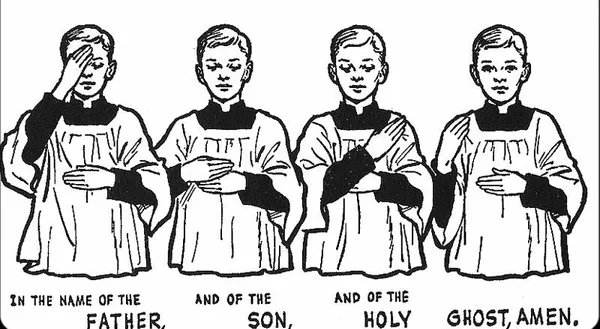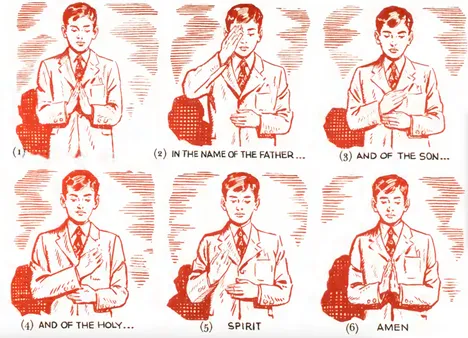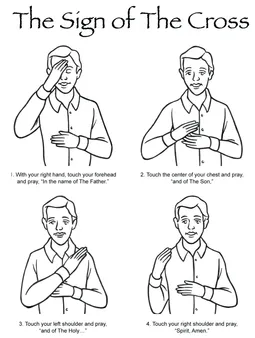Table of Contents
Welcome to Kizworld, where we delve into the profound symbolism and practical significance of the cross. Join us on a journey to explore the origins, diverse forms, and the art of crafting a cross. Discover how this potent symbol can be harnessed for personal growth and explore its profound meanings in Christianity and beyond. Uncover the cross's captivating presence in art, literature, and popular culture, revealing its enduring impact on human history. Learn "How to do a cross" and delve into its rich symbolism with kizworld.
How to do a cross: A step-by-step guide for beginners
I. Draw a Vertical Line
Draw a Vertical Line
To draw a vertical line, start by placing the pencil or pen at the top of the paper. Then, apply gentle pressure and move the pencil or pen straight down the page, keeping it perpendicular to the horizontal lines. Maintain a steady hand and avoid making any sudden movements or changes in direction. Once you reach the bottom of the page, release the pressure and lift the pencil or pen off the paper.
Here are some tips for drawing a vertical line:
- Use a ruler or straightedge to help you draw a straight line.
- Start with a light touch and gradually increase the pressure as you draw the line.
- Keep your hand steady and avoid making any sudden movements.
- Draw the line in one continuous motion, without lifting the pencil or pen off the paper.
Vertical lines are often used to create borders, frames, and other decorative elements. They can also be used to divide text or create columns. By following these tips, you can easily draw a vertical line that is straight and even.
Mistake | How to Avoid |
The line is not straight. | Use a ruler or straightedge to help you draw a straight line. |
The line is too thick or thin. | Start with a light touch and gradually increase the pressure as you draw the line. |
The line is not perpendicular to the horizontal lines. | Keep your hand steady and avoid making any sudden movements. |
The line is not drawn in one continuous motion. | Draw the line in one continuous motion, without lifting the pencil or pen off the paper. |
With a little practice, you will be able to draw vertical lines that are straight, even, and consistent. This skill will come in handy for a variety of projects, from creating artwork to writing notes.
Here are some additional tips for drawing vertical lines:
- If you are drawing a long vertical line, you may want to use a T-square or other drafting tool to help you keep the line straight.
- You can also use a piece of masking tape to create a temporary guideline for your vertical line.
- Once you have drawn your vertical line, you can use it as a reference point for drawing other lines or shapes.
By following these tips, you can easily draw vertical lines that are straight, even, and consistent. This skill will come in handy for a variety of projects, from creating artwork to writing notes.
If you are having trouble drawing a vertical line, there are a few things you can try:
- Make sure that your pencil or pen is sharp.
- Try using a different type of paper.
- Practice drawing vertical lines on a regular basis.
With a little practice, you will be able to draw vertical lines that are straight, even, and consistent. This skill will come in handy for a variety of projects, from creating artwork to writing notes.
II. Draw a Horizontal Line Through the Center of the Vertical Line
Draw a Horizontal Line Through the Center of the Vertical Line
Creating a horizontal line through the center of the vertical line creates the base of the cross. An optimal cross-shaped structure requires accurate alignment of the lines. You can ensure this precision by using a steady hand and a ruler. First, place your ruler horizontally on the vertical line, ensuring that the ruler's center aligns with the vertical line's center. Use a pencil or pen to lightly draw a line across the vertical line, forming a horizontal line. This horizontal line will bisect the vertical line, forming the base of your cross.
Step | Description |
Measure the lengths | Determine the desired measurements for the cross's height and width. |
Cut the sticks | Use a saw to cut the sticks according to the measured lengths. |
Create the vertical line | Plant one of the sticks vertically into the ground. |
Draw the horizontal line | Use a pencil or pen to mark the center of the vertical stick. Then, draw a horizontal line at the marked point. |
Now that you have created the horizontal line, you can move on to the next step, which is securing the horizontal line to the vertical line. Learn how to attach the horizontal line to the vertical line securely.
III. Angled Crosses
Angled Crosses
A captivating variation among cross designs, angled crosses are formed by beams arranged at oblique angles, creating dynamic and striking visuals. These captivating structures are often crafted using wood, metal, or stone, lending them a unique aesthetic appeal.
- Angled Crosses: A Striking Variation in Cross Design
- Wood, Metal, or Stone: Diverse Materials for Unique Aesthetics
The intriguing allure of angled crosses lies in their diversity, with each material choice imparting a distinctive character. From the rustic allure of weathered wood to the sleek elegance of polished metal, angled crosses can effortlessly complement various architectural styles, adding a touch of dynamism to both interior and exterior spaces.
Material | Characteristics |
|---|---|
Wood | Rustic, Warm, Traditional |
Metal | Sleek, Modern, Industrial |
Stone | Timeless, Durable, Elegant |
Angled crosses hold significance beyond their visual appeal, often serving as powerful symbols of protection, guidance, and inspiration. Many cultures across the globe associate angled crosses with ancient traditions, religious beliefs, and spiritual practices, imbuing them with deep cultural and spiritual significance.
- Cultural Significance: Symbolism and Traditions Across the World
- Religious Symbolism: A Profound Representation of Faith and Devotion
Whether gracing the interiors of churches, adorning the exteriors of historic buildings, or adorning personal jewelry pieces, angled crosses captivate with their unique design, rich symbolism, and enduring appeal.
As a symbol of faith, hope, and inspiration, the angled cross has found its way into various artistic expressions, from intricate paintings and sculptures to captivating works of literature and music. Its enduring charm has inspired countless artists, musicians, and writers throughout history, leaving a lasting legacy in the world of creative endeavors.
IV. Squaring the Cross
Squaring the Cross
The cross is often depicted as a flat, two-dimensional object, but in reality, it is a three-dimensional object with a distinct shape. The cross can be squared, meaning that it has four equal arms that extend in all directions. This shape is often used to represent the cross in art, architecture, and religious symbolism.
The Square Cross in Christianity
In Christianity, the squared cross is often seen as a symbol of equality and balance. The four arms of the cross represent the four directions of the compass, or the four corners of the earth. This symbolism suggests that the cross extends to all people and places, regardless of their location or circumstances. The squared cross is also sometimes seen as a representation of the four evangelists: Matthew, Mark, Luke, and John.
The squared cross is a popular shape for Christian crosses because it is easy to construct and can be made from a variety of materials. It is also a versatile shape that can be used in a variety of settings, from churches to homes to public spaces.
Examples of Squared Crosses
- The cross on top of the St. Peter's Basilica in Rome is a squared cross.
- The cross worn by the Pope is a squared cross.
- The cross on the flag of England is a squared cross.
- The cross on the Seal of the United States is a squared cross.
The squared cross is a powerful symbol with a rich history and tradition. It is a reminder of the sacrifice of Jesus Christ and of the salvation that he offers to all people.
Creating a Squared Cross
- Start with a piece of wood or metal that is long enough to make the four arms of the cross.
- Measure and mark the center of the piece of wood or metal.
- Draw a line from the center point to each end of the piece of wood or metal.
- Cut along the lines to create the four arms of the cross.
- Sand the edges of the cross to smooth them out.
- Stain or paint the cross the desired color.
Here are some other examples of squared crosses:
- The Difference Between Catholicism and Protestantism
- The Most Common Christian Symbols and Their Meanings
- The History and Origin of Christianity
V. Conclusion
The cross stands as a testament to humanity's enduring search for meaning, purpose, and connection with the divine. Its multifaceted symbolism and diverse expressions across cultures and time periods underscore its profound impact on human history. As we continue to explore the depths of its significance, the cross remains an enduring symbol of faith, hope, and the enduring human spirit.